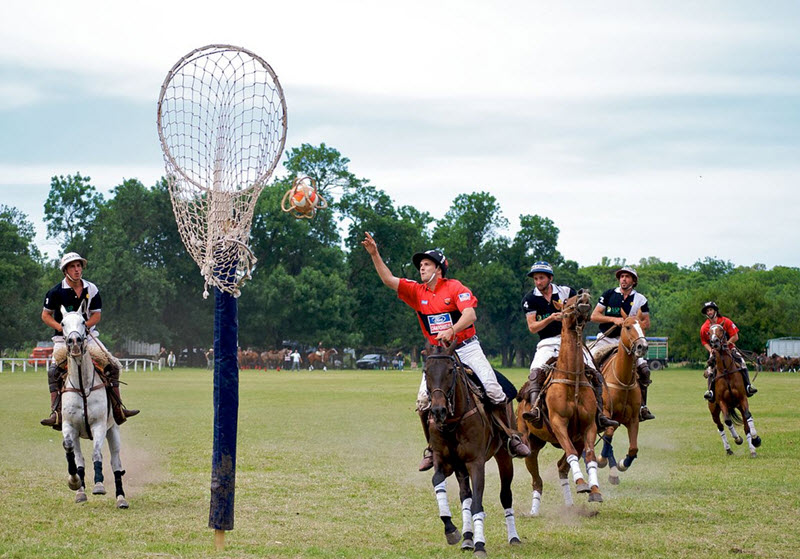Pato, also known as juego del pato, had been the official national sport of Argentina since 1953, but the history of pato in Argentina goes back much longer.
In Argentina, pato is played both professionally and by amateurs. It is especially popular during a type of weekend fairs that also includes Argentine rodeo (doma).
Pato is the national sport of Argentina by virtue of being developed in Argentina, and not because it is the most played or watched sport in the country. The most played and watched sport is association football (soccer), but that game did not arise in Argentina and it follows rules created in another part of the world. The rules for modern Pato were established in Argentina in the 1930s, but the game has been played there (in a more violent fashion) since the 1600s.

The basics
Pato is a ball game played on horseback, with some similarities to polo. It is an outdoor team sport played on a grass field. In modern pato, two teams play against each other, and each team is comprised of four members.
All players are seated on horseback while fighting for possession of a ball. You score by throwing the ball through a vertically positioned ring. It is thus a bit similar to basketball in this regard, but basketball uses a horizontal ring.
The winning team is the one with the most goals scored after six 8-minute-long sessions.
The ball
The inflated ball, which is made from leather, has six leather handles that makes it easier to grab.
The ball is 40 cm in diameter, handle-to-handle.
The ball weighs 1050 grams – 1250 grams.
The ring
The rings are 100 cm in diameter and sits vertically atop 240 cm tall poles. When a ball has entered through the ring, it is held in place by a closed net which extends for 140 cm.
The field
Field length: 180-220 m
Field width: 80-90 m
Important rules
- When you hold the pato (ball), you must ride with that arm outstretched to give rival players a chance to tug the pato and steal it. Failing to extend the arm properly is an offence called negada.
- Tugging the pato from the holder is known as cinchada. During a cinchada attempt, both players must stand on the stirrups, and hold the reins in the hand not involved in the cinchada.
Organization
The highest governing body of pato in Argentina is Federación Argentina de Pato y Horseball (Argentine Federation of Pato and Horseball).
History
Pato is the Spanish word for duck, so ”juego del pato” means ”game of the duck”.
The old version of pato actually used a live duck inside a basket instead of a ball.
The oldest written accounts of pato being played are from the 1610s. Back then, the playing field would typically be the distance between two estancias (ranches), the team who managed to reach their own casco (ranch house) with the duck would win the match.
Controversy
Historically, pato was associated with violence and accidents, and many players were trampled underfoot. Also, knife fights started in the heat of the game would cause serious injury and even death.
Understandably, pato has many critics, including members of the Catholic church. In 1796, a catholic priest even went as far as insisting that a person who died due to a game of pato should be denied a Christian burial.
Throughout the 1800s, the government made notable efforts to prevent people from playing pato, and plenty of Government ordinance were issued that outright forbid the game.
Legit imacy
In the 1930s, the ranch owner Alberto del Castillo Posse drafted a set of rules for pato, largely inspired by the rules for modern horse polo. These rules made pato less dangerous and less violent, and playing pato thereby became more acceptable.
The National Game of Argentina
In 1953, President Juan Perón declared pato to be the national game of Argentina.
